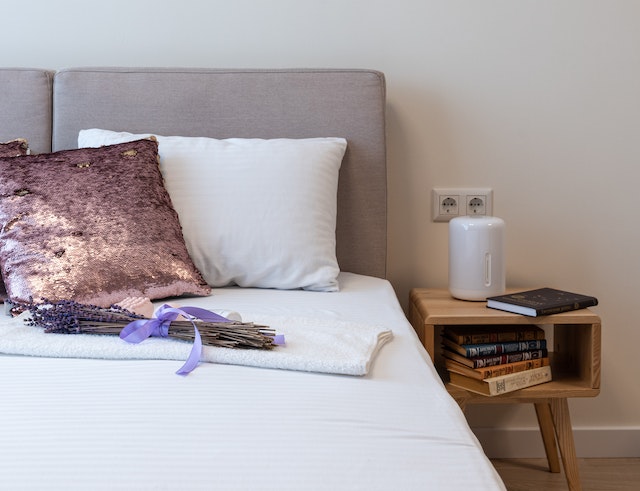Sleeping Position Tips for a Better Night’s Rest
There are some affiliate links below, but they are all products I highly recommend. For more info, view my disclosure here.
When it comes to getting a good night’s sleep, the position you sleep in can make a big difference. Sleeping in the wrong position can lead to aches and pains, poor sleep quality, and even health problems over time. What is the best sleeping position for you? Let’s take a closer look at the options.
One of the most popular sleeping positions is on your back. This position is often recommended by healthcare professionals as it can help to keep your spine and neck in a neutral position, reducing the risk of pain and discomfort. However, sleeping on your back can also exacerbate snoring and sleep apnea, so it may not be the best option for everyone. If you’re a back sleeper, try using a pillow to prop up your head and neck slightly to help keep your airways open.

Understanding Sleep Positions
The Science of Sleep
Sleep is an essential part of our daily routine, and it is crucial to get a good night’s sleep to ensure optimal health and well-being. The position you sleep in can have a significant impact on your sleep quality and overall health. The science behind sleep positions is based on the alignment of your spine and the pressure points on your body.
When you sleep, your body should be in a neutral position, with your spine in a natural alignment. This alignment allows your muscles and joints to relax, and your body can recover from the day’s activities. The best sleeping position is the one that keeps your spine in a neutral position, and your head, neck, and shoulders aligned.
Common Sleeping Positions
There are three common sleeping positions: stomach, side, and back. Each position has its advantages and disadvantages, and the best position for you depends on your personal preference and any underlying medical conditions.
Stomach Sleeping
Stomach sleeping is the least recommended position as it puts pressure on your spine, neck, and joints. It can also cause breathing difficulties and lead to wrinkles and sagging skin. However, if you have sleep apnea, stomach sleeping may be beneficial as it can help keep your airways open.
Side Sleeping
Side sleeping is the most popular sleeping position, and it is recommended for most people. It helps reduce snoring and can relieve acid reflux and heartburn. However, side sleeping can cause shoulder and hip pain if you do not have the right mattress and pillow support.
Back Sleeping
Back sleeping is the best position for spinal alignment and can help reduce back and neck pain. It also helps prevent wrinkles and sagging skin. However, back sleeping can worsen snoring and sleep apnea, and it is not recommended for people with sleep apnea.
Posture and Spine Alignment
Your posture and spine alignment are crucial factors in determining the best sleeping position for you. Maintaining good posture during the day can help improve your sleep quality at night. A good posture keeps your spine in a neutral position, and it can help reduce back and neck pain.
Understanding sleep positions is essential to ensure optimal sleep quality and overall health. The best sleeping position for you depends on your personal preference, medical conditions, and the alignment of your spine and pressure points. It is recommended to maintain good posture during the day to improve your sleep quality at night.
Benefits of Proper Sleep Posture
Getting a good night’s sleep is essential for your overall well-being, and the proper sleep posture can help you achieve it. Sleeping in the correct position can provide numerous benefits, including:
Spinal Alignment and Back Pain
Sleeping in the right position can help maintain the natural curve of your spine, which can prevent back pain. If you sleep in a position that doesn’t support your spine’s natural alignment, it can cause discomfort and pain in your back. Sleeping on your side with a pillow between your legs is an excellent position for spinal alignment and reducing back pain.
Reducing Snoring and Sleep Apnea
Snoring and sleep apnea are common sleep disorders that can be caused by sleeping in the wrong position. Sleeping on your back can cause your tongue and soft tissues in your throat to collapse, leading to snoring and sleep apnea. Sleeping on your side can help reduce snoring and sleep apnea by keeping your airways open.
Improving Circulation and Reducing Heartburn
Sleeping in the right position can also improve blood flow and reduce heartburn. Sleeping on your left side can help improve blood flow to your heart and reduce the risk of developing heart disease. It can also help reduce acid reflux and heartburn by keeping your stomach below your esophagus.
Sleeping in the right position can provide numerous benefits for your overall health and well-being. By ensuring proper spinal alignment, reducing snoring and sleep apnea, and improving circulation and reducing heartburn, you can achieve a good night’s sleep and wake up feeling refreshed and energized.
Choosing the Right Pillow and Mattress
Getting a good night’s sleep is essential for your overall health and well-being, and choosing the right pillow and mattress can make all the difference. Here are some tips to help you select the perfect pillow and mattress for your needs.
Pillow Selection for Neck Support
When it comes to choosing a pillow, the most important factor to consider is neck support. A good pillow should keep your neck aligned with your spine, which can help prevent neck pain and stiffness.
There are a variety of pillows available on the market, including memory foam, down, and synthetic materials. Memory foam pillows are great for neck support as they conform to the shape of your neck and head. Down pillows are soft and comfortable, but they may not provide enough support for some people. Synthetic pillows are a good option for those with allergies, but they may not be as durable as other materials.
When selecting a pillow, consider your sleeping position. If you sleep on your back, a thinner pillow is usually best. If you sleep on your side, a thicker pillow may be necessary to keep your neck aligned. Stomach sleepers should opt for a very thin pillow or no pillow at all to avoid neck strain.
Mattress Types for Body Support
Choosing the right mattress is just as important as selecting the right pillow. A supportive mattress can help alleviate back pain and improve sleep quality.
There are several types of mattresses available, including innerspring, memory foam, latex, and hybrid. Innerspring mattresses are the most common and are typically the least expensive. However, they may not provide enough support for those with back pain. Memory foam mattresses are great for body support as they contour to your body shape. Latex mattresses are durable and provide good support, but they can be expensive. Hybrid mattresses combine the best of both worlds, with a coil support system and a memory foam or latex top layer.
When selecting a mattress, consider your sleeping position and any back pain or other issues. If you sleep on your back, a medium-firm mattress is usually best. If you sleep on your side, a softer mattress may be necessary to cushion your hips and shoulders. Stomach sleepers should opt for a firmer mattress to keep their spine aligned.
By selecting the right pillow and mattress, you can improve your sleep quality and reduce pain and stiffness. Take the time to consider your needs and preferences when selecting these important sleep accessories.
Special Considerations for Different Populations
Sleep Positions During Pregnancy
Pregnancy can be a challenging time for sleep, as the growing belly can make it difficult to find a comfortable position. It is recommended that pregnant women sleep on their left side to improve blood flow to the fetus and prevent pressure on the liver. Placing a pillow between the knees can also help to align the hips and reduce strain on the lower back.
Sleeping Tips for Older Adults
As you age, it becomes more important to prioritize sleep and establish a consistent sleep routine. Older adults may find it helpful to sleep on their back with a pillow under their knees to reduce pressure on the spine. Avoiding caffeine and alcohol before bed can also improve sleep quality.
Positional Therapy for Sleep Disorders
Positional therapy involves training the body to sleep in a specific position to alleviate sleep apnea or snoring. This may involve sleeping on one’s side or using a special pillow to keep the head and neck in a certain position. Consult with a healthcare provider before beginning positional therapy, as it may not be appropriate for all patients.
Finding the right sleep position can greatly improve the quality of your sleep and overall health. By considering the specific needs of different populations, you can make informed choices to support your sleep health.
Practical Tips for Improving Sleep Quality
If you struggle with getting a good night’s sleep, there are practical steps you can take to improve your sleep quality. Two key areas to focus on are adjusting your sleep position for comfort and making lifestyle changes to enhance your sleep.
Adjusting Sleep Position for Comfort
The position you sleep in can have a significant impact on the quality of your sleep. Here are some tips to help you adjust your sleep position for comfort:
- Back sleepers: Try placing a pillow under your knees to reduce pressure on your lower back. This can also help alleviate hip pain.
- Side sleepers: Place a pillow between your knees to keep your hips in alignment and reduce joint pain. You can also try hugging a pillow to your chest for added comfort.
- Stomach sleepers: This position can be tough on your neck and back. If possible, try to transition to sleeping on your back or side. If you must sleep on your stomach, try using a thin pillow or no pillow at all to reduce strain on your neck.
Lifestyle Changes to Enhance Sleep
In addition to adjusting your sleep position, there are lifestyle changes you can make to enhance your sleep quality. Here are some tips:
- Stick to a consistent sleep schedule: Go to bed and wake up at the same time every day, even on weekends.
- Create a relaxing bedtime routine: This can include taking a warm bath, reading a book, or practicing relaxation techniques like deep breathing or meditation.
- Make your bedroom a sleep-friendly environment: Keep your bedroom cool, dark, and quiet. Consider investing in blackout curtains or a white noise machine if necessary.
- Limit screen time before bed: The blue light emitted by electronic devices can interfere with your body’s natural sleep-wake cycle. Try to avoid using screens for at least an hour before bed.
- Exercise regularly: Regular exercise can help reduce stress and promote better sleep. Just make sure to finish your workout at least a few hours before bedtime.
By making these simple adjustments to your sleep position and lifestyle, you can reduce pressure and stress on your body, alleviate hip and joint pain, and improve the quality of your sleep.






